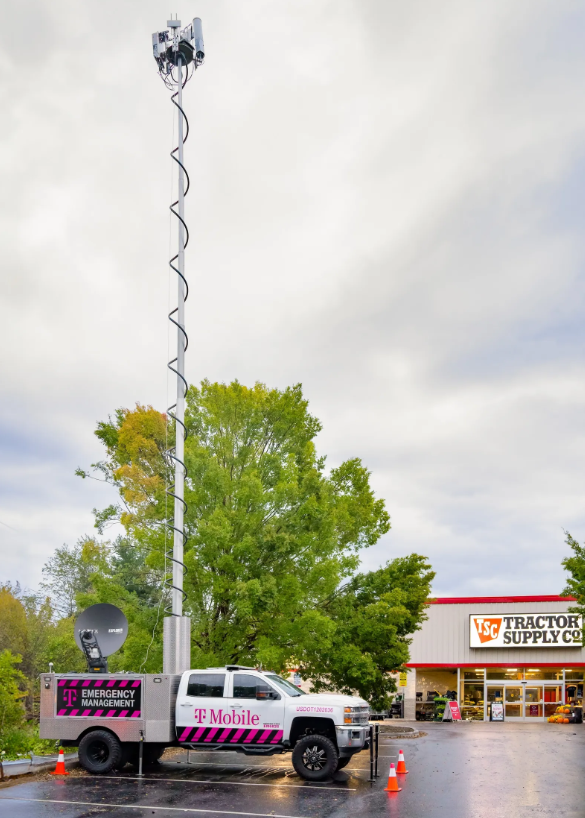Hurricane Helene response.
October 6, 2024
admin
#helene #teamDTL #disastertech #communucations

Although DTL doesn’t have a physical team in North Carolina at the moment, we are actively responding to the devastation caused by Hurricane Helene. Our remote team is working diligently behind the scenes, focusing on data analysis and damage assessment. We are also supporting on-the-ground organizations by assisting with the planning and coordination of their relief efforts.
Below is a summary of the impact Hurricane Helene has had on North Carolina’s telecommunications infrastructure and services, as well as the critical role telecommunications are playing in the ongoing relief operations.
Comprehensive Report on the Impact of Hurricane Helene on Telecommunications Infrastructure and Services in North Carolina
Overview
In late September 2024, Hurricane Helene devastated North Carolina, severely disrupting telecommunications infrastructure, especially in the western and mountainous regions of the state. The storm unleashed catastrophic rainfall, flooding, landslides, and tornadoes, which led to extensive power outages and downed communication lines. This caused widespread communication blackouts, hampering emergency responses and complicating rescue operations across the state.
Geographic Impact and Disruptions
Western North Carolina
Western North Carolina, particularly the mountainous regions, bore the brunt of Hurricane Helene’s destructive forces. Cities like Asheville and surrounding counties, including Buncombe, Haywood, and Yancey, experienced severe damage due to flooding and landslides. Buncombe County, one of the hardest-hit areas, reported that approximately 600 people were unaccounted for by October 4, 2024 (Poynter). The region faced severe communication disruptions as power outages compounded the challenges of repairing downed communication lines.
In Asheville, many residents endured days without power, relying on radio as the primary means of communication(Wikipedia). Radio stations such as Blue Ridge Public Radio and 99.9 Kiss Country became crucial lifelines, broadcasting continuous updates on rescue operations and information on essential resources, including water, food, and medical supplies(Poynter).
In rural areas like Yancey County, the lack of cellular service created extended communication blackouts. Residents had to travel to higher altitudes to get minimal cellular service. The difficult terrain further delayed the restoration of telecommunications infrastructure, including cell towers(Poynter).
Tornadoes and Flooding in Other Regions
In addition to flooding, Hurricane Helene spawned seven tornadoes in North Carolina, exacerbating the destruction. A particularly severe tornado in Rocky Mount (northern part of the state) destroyed communication towers and damaged at least 14 buildings, disrupting cellular services in the area. In counties like Avery and Cleveland, widespread flooding isolated entire communities, sweeping away telephone poles and power lines(Wikipedia) (NC DPS).
Impact on Telecommunications Infrastructure
Telecommunications Failures
Hurricane Helene caused extensive damage to both wired and wireless telecommunications systems, crippling the state’s ability to respond to the crisis effectively. Power outages affected tens of thousands of residents, and by October 2, the Federal Communications Commission (FCC) reported that nearly 50% of the state’s mobile services were down, though this improved to 3% by October 4. At the height of the storm, around 195,000 customers were without power in counties like Carteret, New Hanover, and Onslow. Despite rapid mobilization, utility providers like Duke Energy struggled to restore services due to road closures caused by flooding, mudslides, and debris, with over 400 roads still closed as of October 5, 2024.
Cellular Service Disruptions
Telecommunications companies, including Verizon and AT&T, deployed repair crews to restore cell towers, but full restoration was projected to take weeks due to the severity of the damage. Reports indicated that more than 60,000 North Carolinians were without internet service as of October 1. Emergency communication tools like satellite units and portable radio transmitters were deployed to help mitigate the lack of cellular and internet service, but the widespread damage slowed recovery.
Emergency Response and Recovery Efforts
Federal and State Assistance
The federal government, through FEMA, played a critical role in providing emergency telecommunications support. FEMA deployed more than 40 Starlink units, portable satellite systems capable of providing high-speed internet access, to ensure essential communications in areas hardest hit by the storm. These units allowed first responders and residents to maintain connectivity during the critical early stages of recovery. Additionally, FEMA activated its Individual Assistance Program, enabling affected residents to apply for aid via phone or online, though internet outages hindered this process in some regions.
As part of the broader recovery efforts, over 500 FEMA personnel were deployed to North Carolina. They coordinated search and rescue operations, rescuing or assisting more than 2,100 individuals affected by the hurricane. FEMA also delivered essential supplies such as millions of meals and liters of water to isolated communities(NC DPS).
Role of Non-Governmental Organizations and Local Efforts
Local radio stations, media outlets, and volunteers also played vital roles in the recovery process. The Asheville Citizen Times used text messaging services to keep residents informed, while Blue Ridge Public Radio provided updates on emergency press conferences to ensure that residents without internet access could stay informed(Poynter).
Non-governmental organizations like the American Red Cross and United Way offered communication assistance by setting up emergency phones and distributing battery-powered radios. Amateur radio operators (HAM radio) also became critical, particularly in isolated areas where traditional communication channels failed. These operators, with battery-powered radios, enabled coordination of relief efforts and welfare checks(Poynter) (NC DPS).
Contribution of HAM Radio Operators
In response to the telecommunications outages, amateur radio operators played a crucial role in facilitating communication where traditional networks failed. These operators are capable of maintaining communications through the use of battery-powered radios, enabling them to relay important information and coordinate relief efforts(WCNC). For example, a ham radio operator named Dan Gitro was instrumental in providing emergency communications and welfare checks. He reported that many people relied on the network to find out about closed roads and check on loved ones(WCNC). The ham radio community became an essential lifeline, with operators helping coordinate responses and ensuring that vital information flowed during the chaotic aftermath of the storm.
Starlink’s Role in Relief Efforts
During the aftermath of Hurricane Helene in North Carolina, 40 Starlink units were initially deployed to assist with restoring communications, especially in areas severely impacted by the storm. Additionally, 140 more Starlink units were shipped to further support the restoration of the telecommunications infrastructure. These units were vital in reconnecting emergency responders and communities that were isolated due to the widespread damage caused by the hurricane. Each county’s Emergency Operations Center received a Starlink unit to aid in communications during recovery efforts. Starlink also offered free service to affected residents, ensuring they could stay connected during the storm’s aftermath. This technology was particularly beneficial in areas where cellular infrastructure was slow to recover.
Fatalities and Statistics
- Fatalities: 119 people lost their lives across North Carolina, with more than 200 individuals still unaccounted for as of early October. Most fatalities occurred in the western counties, where communication blackouts delayed rescue efforts (NC DPS).
- Power Outages: At the peak of the storm, over 200,000 customers were without power, with severe outages in counties like Buncombe, Avery, and Haywood(Wikipedia).
- Telecommunication Outages: Tens of thousands of residents experienced cell service disruptions for up to 48 hours, with isolated communities facing even longer delays due to road closures and damaged infrastructure(Poynter).
Conclusion
Hurricane Helene’s impact on North Carolina’s telecommunications infrastructure highlighted the vulnerabilities of modern communication systems during natural disasters. The hurricane caused widespread outages, severely delayed emergency response efforts, and isolated entire communities. However, the rapid deployment of alternative communication tools, including local radio stations, HAM radio operators, and satellite internet services like Starlink, helped mitigate some of the damage.
While power and telecommunications are being gradually restored, full recovery may take weeks due to the extensive damage to roads, power lines, and cell towers. The collaborative efforts of federal agencies, utility providers, volunteers, and local organizations underscore the resilience and adaptability required to restore communication channels and aid recovery in disaster-stricken regions

